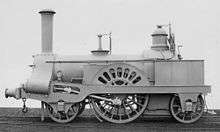Crewe type (locomotive)

The Crewe type locomotive was a series of designs of steam locomotive by Alexander Allan and William Buddicom during the 1840s. It was widely copied elsewhere, particularly in France.
History
During the early 1840s Alexander Allan and William Buddicom of the Grand Junction Railway created the design incorporating inclined outside cylinders and a double frame. It was built due to combat the frequent failure of crank axles on contemporary inside cylinder locomotive designs. The earliest examples were built by Buddicom at Chartreux for the Chemins de Fer de l'Ouest in 1844 where the type became known as 'Le Buddicom'.[2]
The first British examples were built by the newly created London and North Western Railway (LNWR) at Crewe Works in 1845, with a 2-2-2 wheel arrangement for passenger classes and 2-4-0 for freight. These designs were widely copied by other railways both in the UK and overseas during the 1850s and 1860s.[3]
References
- ↑ "Alexander Allan". Grace's Guide. Grace's Guide Ltd. 2016. Retrieved 20 April 2016.
- ↑ Ellis, Hamilton (1968). Pictorial encyclopaedia of railways. Hamlyn. pp. 51–52.
- ↑ Ellis, Hamilton (1949). Some Classic Locomotives. George Allen and Unwin. pp. 19–32.
